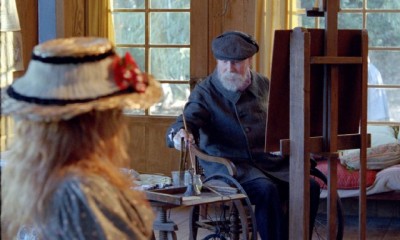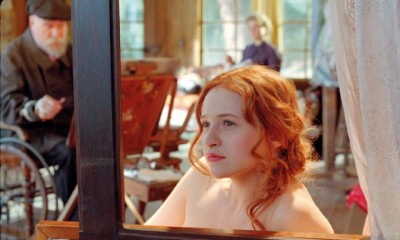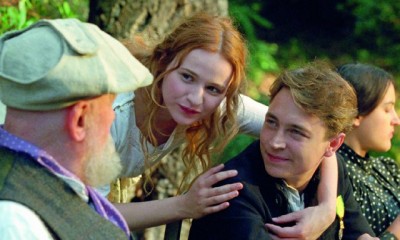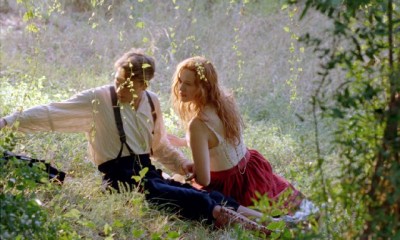
You will undoubtedly see better movies than Gilles Bourdos’ Renoir this year, but there’s a good chance you won’t see a more breathtakingly gorgeous one. The look of the film is almost heartbreaking in its physical beauty. I cannot imagine anyone seeing the settings, the landscapes, the figures, the sense of light and life in Renoir and not longing to inhabit the world of the film. And then not feel a stab of pain because you know you never can. You know realistically that it’s a world created for us by writer-director Bourdos and cinematographer Mark Ping Bing Lee (who shot In the Mood for Love). Oh, sure, those landscapes and those structures exist, but not in the beautifully sun-dappled golden hues of the film, not with those carefully coordinated colors, not with those perfectly costumed (and sometimes uncostumed) characters. It’s like a Renoir painting — an impression of a time and place, not a literal depiction. It’s also a film that suits the line of thought Bourdos has his Pierre-Auguste Renoir (Michel Bouquet) put forth as a kind of artistic credo: “There are enough disagreeable things in life. I don’t need to paint more.”

The film presents a kind of snapshot of one summer in 1915 — four years before the painter’s death. Renoir is 74 and arthritic to the degree that he has to have paintbrushes tied to his hand. He finds that walking tires him too much to paint, so he opts for painting (requiring his almost exclusively female house staff to carry him around in a chair). He’s roused from the malaise into which he’s understandably sinking by the arrival of a new model — sent his way by Matisse — named Andrée Heuschling (Christa Theret), but mostly called Dedee. She’s outspoken, troublesome, but Renoir’s artistic ideal — and she would have been more had he been younger. Instead, she becomes romantically involved with Renoir’s middle son Jean (Vincent Rottiers), who is home on leave from the army, having been seriously wounded in the war. For that matter, Renoir’s youngest son, Claude (Thomas Doret, The Kid with a Bike), is interested in her, but at his age it extends to little more than a desire to see her breasts.

It can be said that not much actually happens in the film, but that’s clearly by design. What happens is always more suggested than stated. The character of Renoir himself is deliberately enigmatic. He keeps his emotions to himself — and it’s made clear that it’s always been that way — but they can be seen just beneath the surface. His deep feelings for his late wife are there. His devotion to his ideas of art are inescapable, as is his need for the presence of Dedee. He may never express his deep feelings for his son, Jean, but their final scene together says everything you need to know — if you’ve been paying attention — about his son meaning more to him than his painting.

Renoir is, in some respects, as much about the future filmmaker, Jean, as it is about his father. That it tends to present him as an unformed young man who wanders into the idea of becoming a filmmaker — a goal his older brother Pierre (Laurent Poitrenaux) dismisses as not being for the French — at the behest of Dedee seems simplistic. It probably is, but it’s hard to say where the truth lies. It is certainly true that Renoir’s early films attempted to turn Dedee (then married to him and under the name Catherine Hessling) into a movie star. (His real success and his masterpieces came after they split up.) In some respects, this is a film that perhaps works better — at least as far as Jean Renoir is concerned — if you come to it with some knowledge of the subject, but I don’t think it’s essential. It’s certainly not essential in order to appreciate the amazing world the film creates. Rated R for sequences of art-related nudity and brief language.
Playing at Fine Arts Theatre



This sounds like a kind of third cousin to GODS AND MONSTERS.
I don’t see even a hint of a connection.
I clearly didn’t think as much of this film as you did. For me the undeniable beauty was mostly just coating to an otherwise fairly average and often rather boring movie.
I’m not ready to say I’m sorry I saw it– mostly because I suspect the visual splendor of it will stick in my mind for a while– but the credits were a welcome arrival.
It wasn’t just the beauty of the images, but the way it created its own world with them. I never found it boring, but I wouldn’t “rassle” you over it. I was frankly startled by how many people absolutely loved the film — and by how well it did here.
I was frankly startled by how many people absolutely loved the film — and by how well it did here.
The Tuesday 4 o’clock did better than I would’ve guessed– even with the $5 deal going on. And aside from one visibly restless couple, it seemed most people were quite pleased indeed as they filed out. I’m okay being among the minority when it comes to being underwhelmed by a Renoir type movie. It just means people are supporting the type of fare that we’re lucky to see come around so consistently.
Now why it sounds like this did far better than, say, A Royal Affair is beyond me.
Any explanation I could come up with as to why this should be would be guesswork. I’d immediately suggest that A Royal Affair is a lousy title with a crummy poster, but who knows? Consider: Last week we ran the 1933 WB film Bureau of Missing Persons. This week we ran the 1932 WB film Union Depot. The pictures are not much alike in plots, but the tone is very similar. If anything, I’d have thought that Missing Persons had the edge because it’s a little slicker and has Bette Davis. But the fact is that the audience seemed fairly indifferent to it, and yet they went lollipops over Union Depot — applauding all the way through its credits (it’s an oddity for a film of that era in that the credits are all at the end, so they had a long time to clap). I have no idea what the difference was.